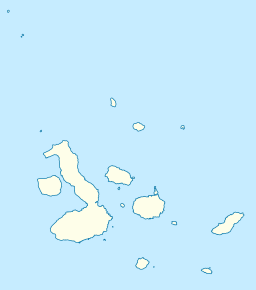Alcedo Volcano facts for kids
Quick facts for kids Alcedo |
|
|---|---|

Alcedo Volcano from SPOT Satellite image
|
|
| Highest point | |
| Elevation | 1,130 m (3,710 ft) |
| Geography | |
| Geology | |
| Mountain type | Shield volcano |
| Last eruption | December 1993 |
Alcedo Volcano is a huge, active volcano on Isabela Island in the amazing Galapagos Islands. It is one of six large shield volcanoes that form Isabela Island. Because Alcedo is in a very remote area, its most recent eruption in 1993 was not even noticed until two years later!
Alcedo is special because it is the only volcano in the Galapagos to have erupted two different types of lava: rhyolite and basalt. It is also home to the largest group of wild Galapagos tortoises. Sadly, their home was once in danger from wild goats that came from other parts of Isabela Island.
Contents
How Alcedo Volcano Formed
Scientists believe Alcedo Volcano first appeared from the sea about 313,000 years ago. It grew over time to be 1130 meters (about 3,700 feet) tall. The top of the volcano has a large bowl-shaped area called a caldera, which is about 6.1 by 7.4 kilometers wide.
Alcedo Volcano is similar to its neighbors, Darwin and Sierra Negra. These volcanoes all have gentle slopes for most of their height. Also, their calderas are not very deep compared to the volcano's total height. Other volcanoes in the Galapagos, like Cerro Azul and Wolf, have much steeper sides and deeper calderas.
The Galapagos Hotspot
Like all volcanoes in the Galapagos, Alcedo was formed by the Galapagos hotspot. A hotspot is a super hot spot deep inside the Earth that melts rock. This melted rock, called magma, then rises to the surface, creating volcanoes. The main hotspot is thought to be under the island of Fernandina, which is to the west of Alcedo.
Even though Alcedo is not directly over the hotspot, it is still active. Its last eruption was in 1993. Because Alcedo is so far away from people, past eruptions were not well recorded. For example, an eruption that happened between 1946 and 1960 was only figured out by looking at old photos. The 1993 eruption was not seen at the time. It was only discovered when an expedition found new craters in 1995!
Different Kinds of Lava
Alcedo is the only volcano in the Galapagos that has erupted rhyolite lava. This type of lava is very thick and sticky. About 120,000 years ago, Alcedo had a series of eruptions that produced rhyolite. One of these eruptions covered the eastern slopes with a lot of volcanic ash and rock, called tephra.
After these rhyolite eruptions, Alcedo started erupting basaltic lava again. Basalt lava is much runnier. Scientists think this change happened because Alcedo moved away from the hotspot over time. This movement changed the type of magma reaching the volcano's magma chamber.
Hot Water Underground
Alcedo also has a hydrothermal system inside it. This means there is hot water flowing underground. The water that comes out is less than 97 degrees Celsius (207 degrees Fahrenheit). But scientists have found that the water deep inside the volcano is much hotter, over 260 degrees Celsius (500 degrees Fahrenheit)! This hot water comes from rainfall that seeps into the ground and stays in the system for about 400 years.
Amazing Wildlife
Alcedo Volcano is famous for its large population of Galapagos tortoises, specifically the Chelonoidis vandenburghi species. In 2003, a study showed that even though there are about 4,000 tortoises on Alcedo, their genetic diversity is very low. This means they are all very similar genetically.
Scientists believe this low diversity happened because the tortoise population dropped to only a few individuals about 100,000 years ago. This big drop was likely caused by a massive eruption of Alcedo Volcano. Luckily, the Alcedo tortoise population has grown back since then.
Threats to Tortoises
When people first discovered the Galapagos Islands, sailors hunted tortoises for food. This put a lot of pressure on the tortoise populations. Later, new problems arose when non-native animals were brought to the islands.
For many years, people thought that wild goats could not cross a 12-kilometer (7.5-mile) wide lava field called the Perry Isthmus. This lava field separated the northern and southern parts of Isabela Island. However, goats were seen crossing it in the early 1970s. By 1998, their population on northern Isabela Island was estimated to be between 75,000 and 125,000!
These goats caused a lot of harm to the environment. They ate plants that were food for the native tortoises. When plants were eaten, watering holes also dried up. To fix this, a big effort called Project Isabela was started. The Galapagos National Park and the Charles Darwin Foundation worked together to remove all the goats from northern Isabela Island. The project finished in 2006, and since then, small trees and shrubs that are part of the tortoises' natural home have grown back quickly.
See also
 In Spanish: Volcán Alcedo para niños
In Spanish: Volcán Alcedo para niños
- List of volcanoes in Ecuador


